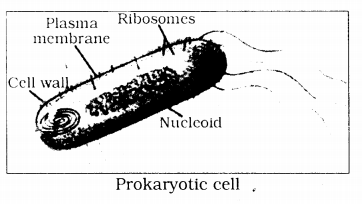Karnataka Board Class 9 Science Chapter 5 The Fundamental Unit of Life
KSEEB Solutions for Class 9 Science Chapter 5 Intext Questions
Question 1.
Who discovered cells, and how?
Answer:
Robert Hooke discovered cells. While examining a thin slice of cork, he saw that the cork resembled the structure of honey comb consisting of many little compartments. Cork is a substance which comes from the bark of a tree. Robert Hooke called these boxes cells.
Question 2.
Why is the cell called the structural and functional unit of life?
Answer:
Each living cell has the capacity to perform certain basic functions. Hence it is called the structural and functional unit of life.
Question 3.
How do substances like CO2 and water move in and out of the cell? Discuss.
Answer:
Some substances like CO2
(Which is cellular waste and requires to be excreted out by the cell) accumulates in high concentrations inside the cell. In the cell’s external environment, the concentration of CO2 is low as compared to that inside the cell. As soon as there is a difference of concentration of CO2 inside and outside a cell, CO2 moves out of the cell, from a region of high concentration, to a region of low concentration outside the cell by the process of diffusion. Similarly, O2 enters the cell by the process of diffusion when the level or concentration of O2 inside the cell decreases. Thus diffusion plays an important role in gasesous exchange between the cells as well as the cell and its external environment.
Question 4.
Why is the plasma membrane called a selectively permicable membrane?
Answer:
The plasma membrane allows or permits the entry and exit of some materials in and out of the cell. It also prevents movement of some other materials. The cell membrane, therefore is called a selectively permeable membrane.
Question 5.
Fill in the gaps in the following tables illustrating differences between prokaryotic and eukaryotic cells. (Answer is filled.)
Answer:
| Prokaryotic cell | Eukaryotic cell |
| 1. Size: generally (1-10\(\mu\)m) 1\(\mu\)m = 10-6 |
1. Size: generally (5-100 \(\mu\)m) |
| 2. Nuclear region Nuclear | 2. Nuclear region well defined and surrounded by a nuclear membrane |
| 3. Chromosome | 3. More than one chromosome |
| 4. Membrane-bound cell absorb | 4. Membrane-bound cell organalles are present. |
Question 6.
Can you name the two organalles we have studied that contain their own genetic material?
Answer:
Nucleus and mitochondria are the two organalles we have studied that contain their own genetic material.
Question 7.
If the organisation of a cell is destroyed due to some physical or chemical influence, what will happen?
Answer:
If the organisation of a cell is destroyed, no growth of plant takes place plant growth is upset.
Question 8.
Why are lysosomes known as suicide bags?
Answer:
Lysosomes help to keep the cell clean by digesting any foreign material as well as worn out cell organalles. Foreign materials entering the cell, such as bacteria or food, as well as old organalles end up in the lysosomes which break them up into small pieces. Hence lysosomes are known as suicide bags.
Question 9.
Where are proteins synthezised inside the cell?
Answer:
Synthesis of proteins take place in Ribosomes.
KSEEB Solutions for Class 9 Science Chapter 5 Textbook Exercises
Question 1.
Make a comparison and write down ways in which plant cells are different from animal cells.
Answer:
|
Plant cell |
Animal cell |
| i) Both cell wall and cell membrane are present. | i) Only cell membrane is present. |
| ii) Plastids are present | ii) Plastids are absent. |
| iii) It has large vacuole | iii) It has small vacuoles. |
In plant cell there is chlorophyll, photosynthesis take place. But in animal cell No photosynthesis.
Question 2.
How is a prokaryotic cell different from a eukaryotic cell?
Answer:
| Prokaryotic cell | Eukaryotic cell |
| i) Nuclear membrane is absent | i) Nuclear membrane |
| ii) It has one chromosome | ii) It has more chromosomes. |
Question 3.
What would happen if the plasma membrane ruptures or break down?
Answer:
If the plasma membrane ruptures or breakdown, No movement of substances take place inside and outside of the plasma membrane.
Question 4.
What would happen to the life of a cell if there was no Golgi apparatus?
Answer:
If there was no Golgi apparatus it is difficult for cell to storage, modification and packaging of products in vesicle will not take place.
Question 5.
Which organelle is known as the powerhouse of the cell? Why?
Answer:
Mitochondria is called as powerhouses of the cell. Because the energy required for various chemical activities needed for life is released by mitochondria in the form of ATP.
Question 6.
Where do the lipids and proteins constituting the cell membrane get synthesised?
Answer:
Lipids and proteins are synthsised in Endoplasmic reticulum.
Question 7.
How does an Amoeba obtain its food?
Answer:
Amoeba obtains food from a process called endocytosis (getting food and other material from its external environment.
Question 8.
What is Osmosis?
Answer:
The random movement of molecules from higher concentration to lower concentration when they are separated by a semipermeable membrane is called osmosis.
Question 9.
(Students should perform this experiment as suggested in the Text Book).
KSEEB Solutions for Class 9 Science Chapter 5 Additional Questions
I. Fill in the blanks:
Question 1.
Cell has small structures called …….
Answer:
organalle.
Question 2.
……. is the special diffusion which takes place through a semipermeable membrane.
Answer:
Osmosis.
Question 3.
Functional segments of DNA are called …….
Answer:
genes.
Question 4.
……. has only cell wall.
Answer:
Plant cell
Question 5.
……. help to keep the cell clean by digesting any foreign material as well as worn-out cell organelles.
Answer:
Lysosomes.
II. Draw a neat diagram of the prokaryotic cell and label the parts.
Answer:
